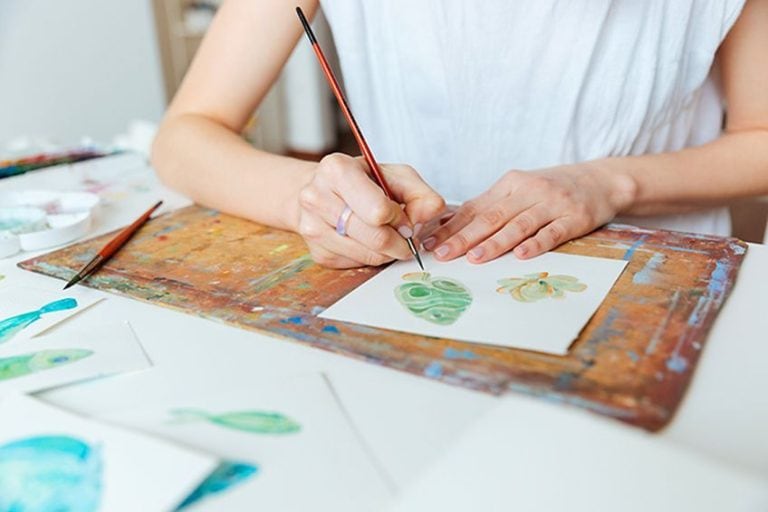Watercolor Landscape – Easy Waterfront Scene Painting Tutorial
Watercolor is a very delicate medium. The best results can often be achieved with a sense of patience as there are dry techniques that can help make our landscaper unique. Watercolor can also require a sense of swiftness as there are wet techniques that need to be worked through before drying. However, at the end of the day, it is painting it and that means there is no right or wrong way. We should approach this tutorial with a sense of ease knowing that we are not trying to achieve something specific. In this tutorial, we will be doing quite a loose and playful watercolor landscape, exploring various techniques that are easy to do for beginners. So, with an awareness of the medium’s capabilities, let us go through a watercolor landscape tutorial.
Table of Contents
- 1 Necessary Materials
- 2 Preparation and Source Image
- 3 An Easy Watercolor Tutorial For Beginners
- 3.1 Step 1: Drawing the scene
- 3.2 Step 2: Wetting the Page
- 3.3 Step 3: Painting the Background and Water
- 3.4 Step 4: Focusing on the Ripples
- 3.5 Step 5: Painting the Reflection of the Dock
- 3.6 Step 6: Painting the Dock In Your Watercolor Scenery
- 3.7 Step 7: Painting the Horizon of Your Watercolor Landscapes
- 3.8 Step 7: Adding Details to Your Watercolor Scenery
- 4 Tips to Remember
- 5 Frequently Asked Questions
Necessary Materials
Firstly we want good paper; any watercolor paper is good and can be bought in your local art shop. However, make sure the grammage of the paper is above 300GSM. We will be using a pencil and ruler to draw our landscape. We will use a set of watercolor brushes, but you can use various brushes for various effects. And lastly, we will be using a set of pan watercolors.

Depending on where you are in the world and what is available to you is completely your choice. However, here are some suggested materials that potentially could be a preferred choice. Lastly, we will use some masking/scotch tape to keep our paper down and in place. Here is a list of the necessary materials for this tutorial.
Preparation and Source Image
What we want to do is prepare our paper on a nice even surface. Then we can begin to cut the scotch tape at the length of our paper both horizontally and vertically. We can stick this tape on all four sides of the paper overlapping onto the paper with a 1cm-2cm width. This is gonna allow us to work our paints through the ends of the paper. This will also produce a beautiful white border around our work to give it a more professional look. We also want to make sure we have some clean water and perhaps another one for giving our brushes a little rise through the process.

Lastly, let us make sure we have our paints nearby and ready for use. In this tutorial we will be drawing from an image on an iPad, however, feel free to use whichever device that is available to you, or alternatively, you can print the image. With our paint, paper, and water all set up let us begin his tutorial. Remember, doing a watercolor tutorial can be done in various ways with various techniques. In this tutorial, we will be doing quite a colorful and loose landscape. So with everything prepared let us begin.
An Easy Watercolor Tutorial For Beginners
With watercolor landscapes and watercolor scenery, we are describing an environment through a series of color arrangements. With the watercolor medium, it is important to understand the way it works with water. Essentially it is a process of layering colors in a way we understand any landscape. This means we develop the background, then the middle ground, and finally the foreground. This helps to develop the watercolor scenery and gives the watercolor landscape a sense of depth.
With that being said let’s get into this easy watercolor landscape tutorial.
Step 1: Drawing the scene
In this tutorial, we will be drawing an interesting scene that depicts a dock in the late afternoon sunset. With watercolor, we can either take on the challenge of literal representation, however another great way to do watercolor is to redefine your source image in your own way. Beginning with your pencil let us begin to draw the scene in our source image as best we can. It’s always good to start with the horizon line which gives us a good sense of how far out the dock should extend.

As we analyze our source image we can see that the dock has foundational beams that support it as well as safety beams that support a handrail. What we want to do is maintain the correct proportions but we can play around with how many aspects of the dock we want to represent.

As long as we draw something interesting and as long as the proportions are correct to guide our painting then we will be fine. What we can do is go back and forth between our source image and drawing trying to encapsulate the shape and perspective of the dock until we are satisfied.

Again, we want to make sure there is something interesting to look at on the dock. So let us try to put in interesting features on the dock that can help to make it a feature in the painting. Another important aspect is the reflection of the dock on the water, which we can draw in now.
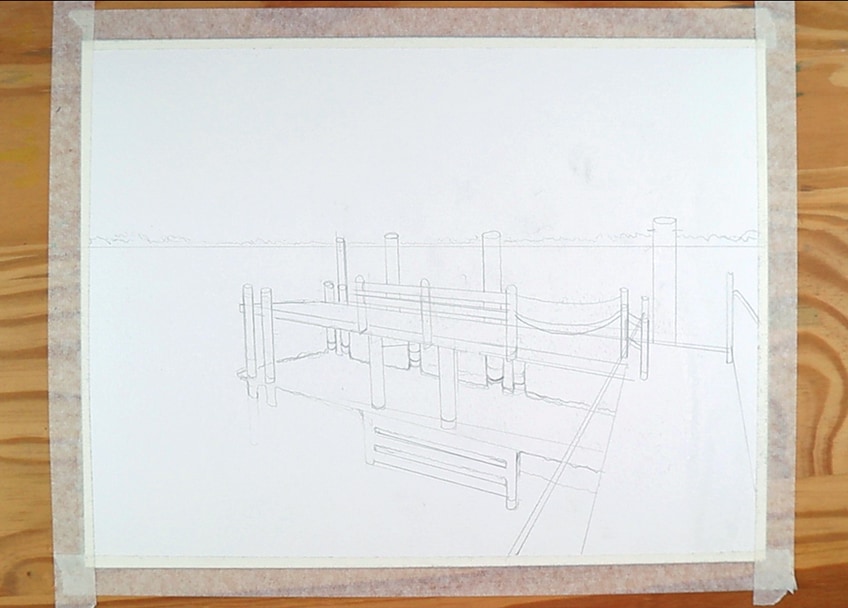
When drawing the shadow of the dock remember that a shadow is often the same in shape. So try to analyze the source image as best you can for this aspect as it can serve the painting well to get these details correct.

Once that is done we can begin to put in the general foliage and city-type shapes along the horizon line. You can develop whatever kind of scenery you like along the horizon line. Just remember that the larger it is the closer it will seem, so a good suggestion is to keep these details somewhat small.
Step 2: Wetting the Page
Here is where we prepare the surface of the paper by wetting the whole page. We want to take a fairly large brush and stroke water evenly along the whole page.
This action is going to help us develop the wet on wet technique which works well for backgrounds.
Step 3: Painting the Background and Water
We can now begin painting our image. How we start is by developing the background. When doing landscapes or even nature paintings with watercolor, this is a great method to use. According to our source image, the color scheme is quite dark, however, a good suggestion is to start with your lightest colors first. Let’s begin putting in our yellows first. Make sure you keep your brush fairly wet so we get that seamless fading effect.

Remember that the water will reflect the sky so we can paint in the colors of the water in relation to the sky. A good suggestion is to begin with the sky and as the colors fade with the watery paper we can put the lighter strokes on the water. We can put in our lighter blues above the sunset. We want to use long wide strokes back and forth to create a seamless fade into the colors.
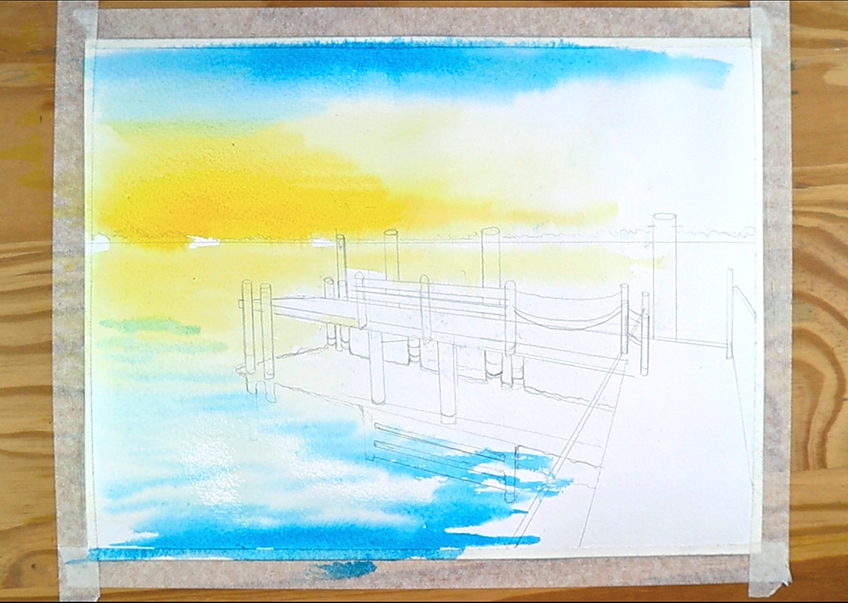
Keep your page wet during this process as it will set up a good foundation to paint over during the tutorial. We want to act fast whilst the page is still wet, so another good idea during this stage is to premix your colors so that the paints are ready. With wide strokes, we can also begin to put in our darker blues.

A good suggestion is to mix a bit of purple and dark blue to create a deeper color that resembles that darker aspect of the sky. Remember to keep the brush fairly wet and your strokes fairly wide. This way the fades of the colors become more seamless. We can also put slightly more dry orange strokes in the yellow close to the sunset.

The paper dries fairly fast which means that if we make paint marks in those dry areas the strokes become more visible. This is helpful for cloudy and watery effects. We can put slight orange strokes in the water close to the horizon line near the sunset.

We can now put a slightly more red streak through the warmest part of the sunset which is generally close to the horizon line. We can also do a similar, but more watered-down stroke in the water. Remember that the water always reflects whatever is in the sky.

Step 4: Focusing on the Ripples
Whilst the background dries let us focus on the water in the foreground. The effect of ripples in the water is best achieved through a side-to-side motion of thick to thin strokes. We do this by a side-to-side flick of the wrist. And in some moments making more jagged shapes.
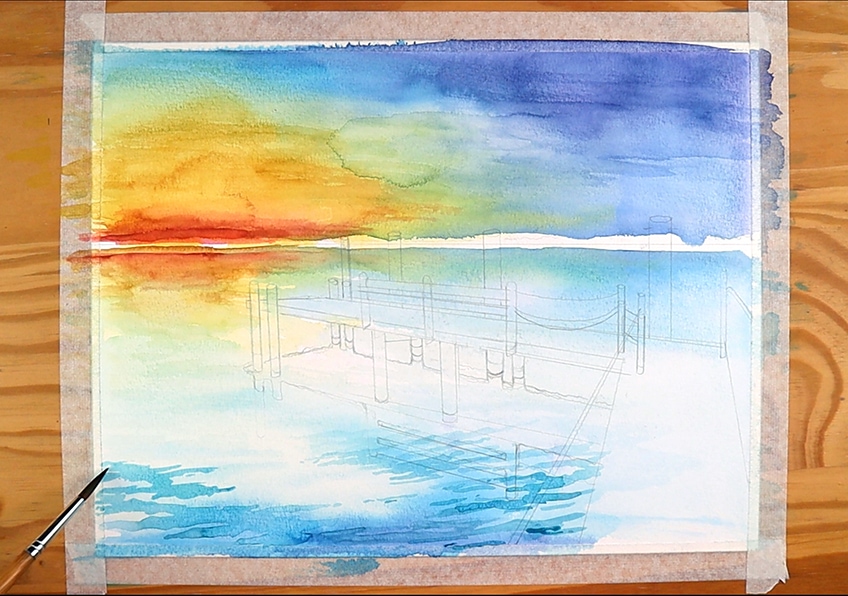
Think of them more as blobs that are jagged from left to right. With both the belly and tip of the brush we achieve this effect by moving side to side. Another important aspect to note is that the ripples of the water are always going to be larger in the foreground which means they are slightly slimmer and eventually nonexistent as they fade into the background.

Step 5: Painting the Reflection of the Dock
We can begin by mixing our blues until we arrive at this darker turquoise blue. We can do this by adding slightly more blue in a mix of blue and green, perhaps a 70 to 30 % ratio. you can mix until you arrive at the color you want. Then we can begin to fill in the area of the reflection with our source image as a reference.

Allow yourself to not focus too much on an even tone. If there is variation in the color of the reflection, that is ok. This gives the painting a little more nuance and allows for it to seem more painterly than drawn. However, you can also take on a more slow and clinical approach.

It all depends on the effect you want, for this tutorial we want to try and keep it loose as it is for a beginner level. Perhaps go through your reflection one more time, giving it a darker tone. make sure it makes sense as it should fall vertically in relation to the posts that stand vertically on the dock. Once this is done, allow it to dry for 30 minutes.
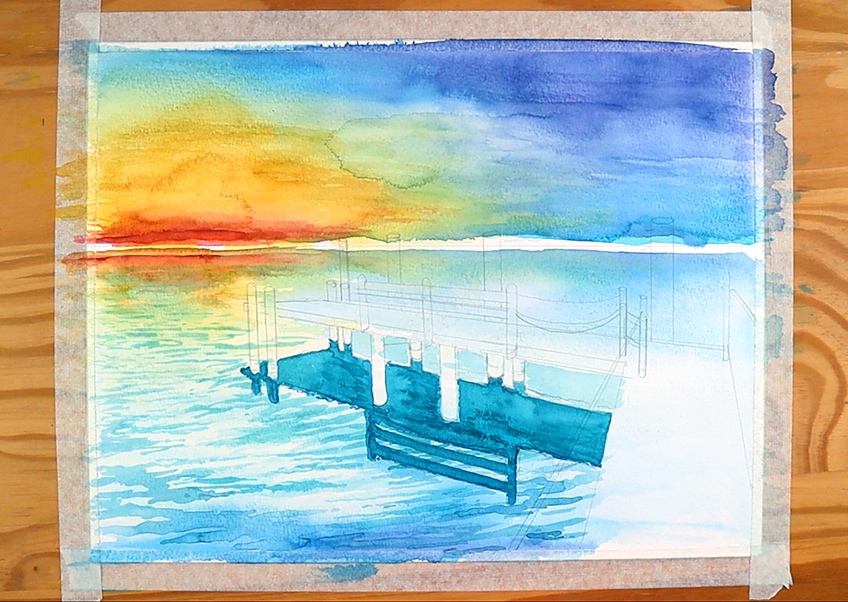
Step 6: Painting the Dock In Your Watercolor Scenery
Once our painting is dry we can now mix a golden brown with our yellow, more yellow than brown, to create a mustard-looking tone. This color contrasts nicely and will serve as the lightest part of the dock. Let’s take a mid-sized brush and begin to make confident marks moving along the surface area of the dock.

Let’s put a touch more brown in the yellow for the posts. We want these posts to be slightly darker because this will indicate that the parts of it that we see are not exposed to light. As we mix our golden-brown with yellow let us cautiously and carefully paint the posts. Move from right to left if you are left-handed and the other way if right-handed.

Whilst the dock is drying, let us take a moment to refine the reflection of the dock by mixing a tone of deep turquoise again. Then, with a fine-tipped brush begin to make slight squiggle marks moving along the outline of the reflection. This will just give it a more watery feel as the reflection sits on the water.

Moving back to the dock, we can take our warm golden color and begin to add in more details such as filling in the posts and creating lines on the dock to represent its wooden structure.

If you still have a mix of yellow and brown put a touch of red in to darken it and make it warm. We will use this for the edging of the pier of the dock. Ultimately, a good rule of thumb is to build onto your already existing paint mixes, building on your lightest tones to the darkest tones in your image. This way you also don’t waste paint.

What we can do is use this darker brown color to add more details to our dock. We can analyze our source image for inspiration to see where and how we can use these colors to make our pier stand out more.

We can use this warmer Oakey red color to create wooden lines on the pier. We do this by taking our fine brushes and carefully making little swift strokes along the plane of our pier. This creates a more wooden texture, bringing the pier out more and allowing it to seem more refined.

Feel free to make any kinds of marks on the dock with this darker color. Be creative and see how the darker color could develop contrast in the image that could enhance it more. Perhaps create shadowing on the posts where light would be less capable of penetrating.
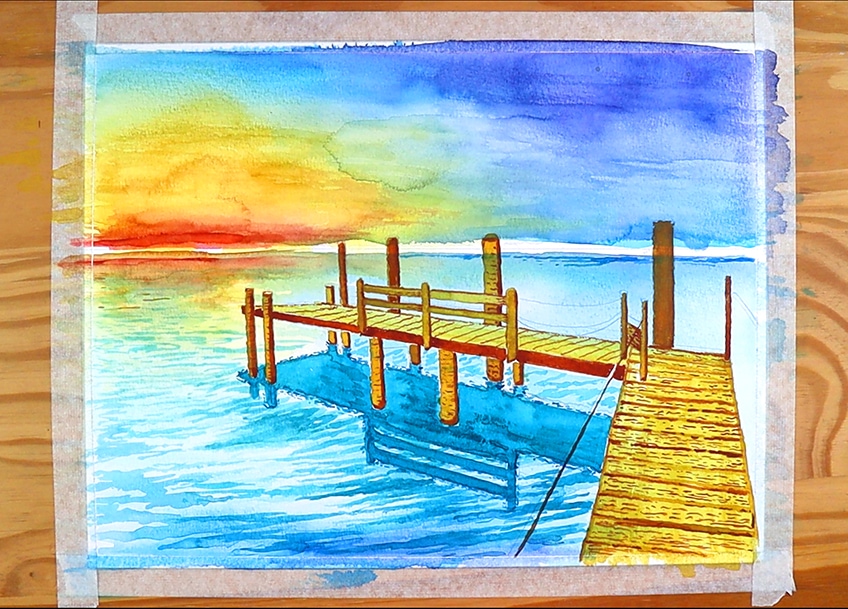
Step 7: Painting the Horizon of Your Watercolor Landscapes
In this part of the tutorial, we will do a cityscape. Mix a darker blue with a touch of black to get a deep blue that almost resembles black. What we want to do is take our fine-tipped brush and begin to make little tiny vertical strokes that suggest a city skyline.
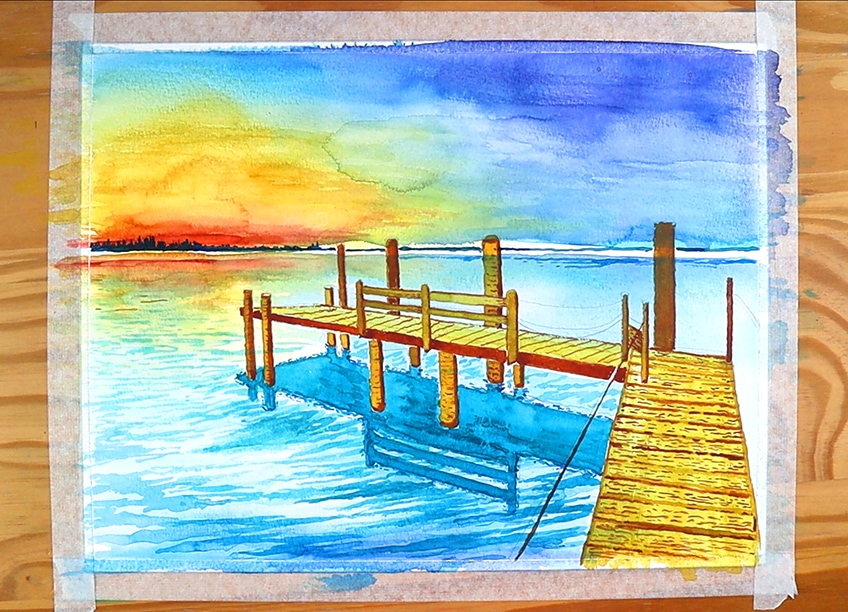
We want to use that dark blue and with a slow and steady movement run it across the page in a horizontal line. you can draw a line over your paint to give you a better sense of linearity as you attempt to make a straight painted line. Give your brush a slight rinse and dab and then do an identical opposite of the cityscape directly underneath the horizon line.

Similar to the reflection of the pier we want to mimic the qualities of the little building shapes in the water. We do not need to worry about perfecting them as the aim here is to give more of a suggestion of the reflection.
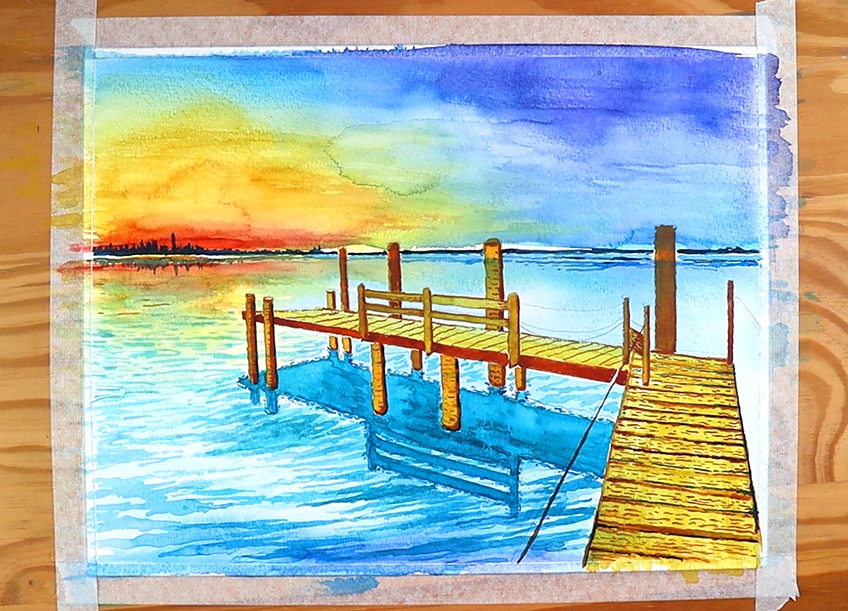
Step 7: Adding Details to Your Watercolor Scenery
We should have a painting at this point that could be considered finished. However, a great suggestion is to always add little details that enhance the painting once you have finished the most important parts. For instance, little marks to bring out the wood of the pier is a good idea.
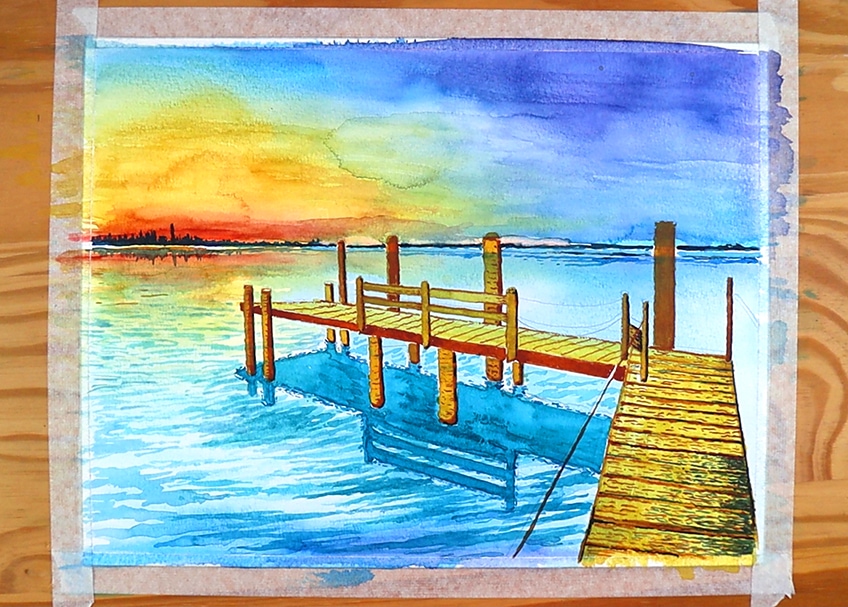
We can add all these little painterly marks to our painting that might give a more detailed effect to the dock in the foreground, bringing out a little more. We can do this for the handrails, strings, and the posts near the pier, all these little moments can help refine the artwork. But remember, painting is about expression so feel free to use this simply as a guide.
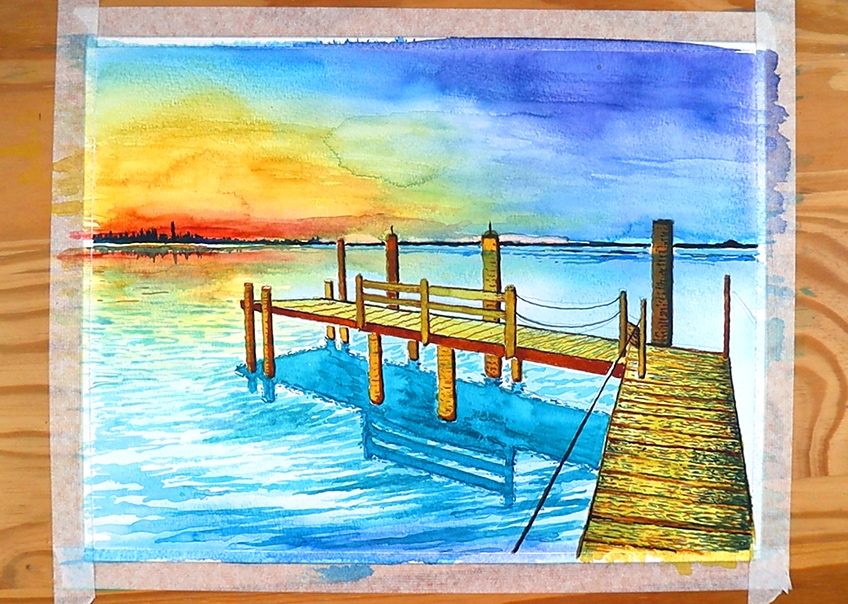
Another good suggestion is to add a darker tone in the sky where the light would fade the most, this would be the top right corner. This tonal range can give a sense of darkness in the distance and just works well with overall contrast in the landscape. Perhaps give the sunset some dry orange strokes for a cloudy effect.
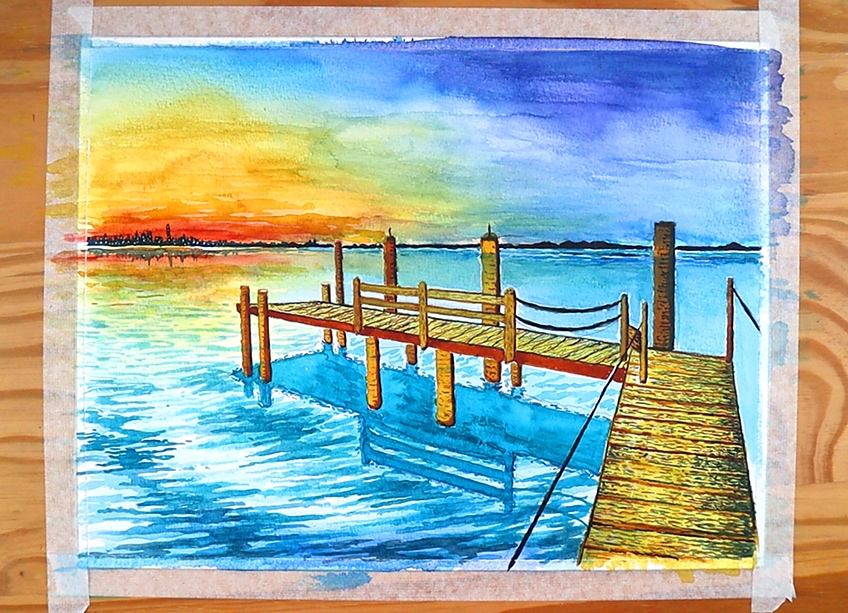
A good suggestion is to touch up the horizon line a little, giving it a slightly darker tone. Another good suggestion would be to make a dark cobalt blue color and add little darker moments to the ripples in the water that is closest to the foreground.
Since we have done a cityscape in the distance of our painting, let’s add some little white dots near the cityscape once our horizon is dry. By doing so we can give an impression of city lights. This can be a fun little detail to add to the artwork, making it playful. Remember to do the same to the reflection in the water near the horizon line.

Make sure to give your painting one last look and a great suggestion is to also learn when to stop. If you feel the painting has a complete feel then allow it to be complete. When doing nature paintings with watercolor or a simple watercolor landscape we can easily overdo it. So remember to stop once you feel it’s complete.

There you have it, an easy seven-step guide to a simple watercolor landscape. All landscapes differ and some are more natural whereas some can be more modern. The same can be said for the color combinations used in a painting, but this is the freedom of painting to feel free to express in a way that you like.
Tips to Remember
Easy watercolor landscapes are a great and peaceful task to take on. You should always remember that it takes time to learn a skill and watercolor landscapes are quite a skill that requires some time. There are many techniques and tricks to learn when doing watercolor painting.
- First of all, take your time, take breaks in between the process and have fun.
- Do not wet the paper too much in the beginning. Make sure it is all completely wet evenly, but keep the layer on the surface as thin as possible.
- Whether doing nature paintings with watercolor or modern watercolor landscapes, always develop the background first and then paint the foreground over that background.
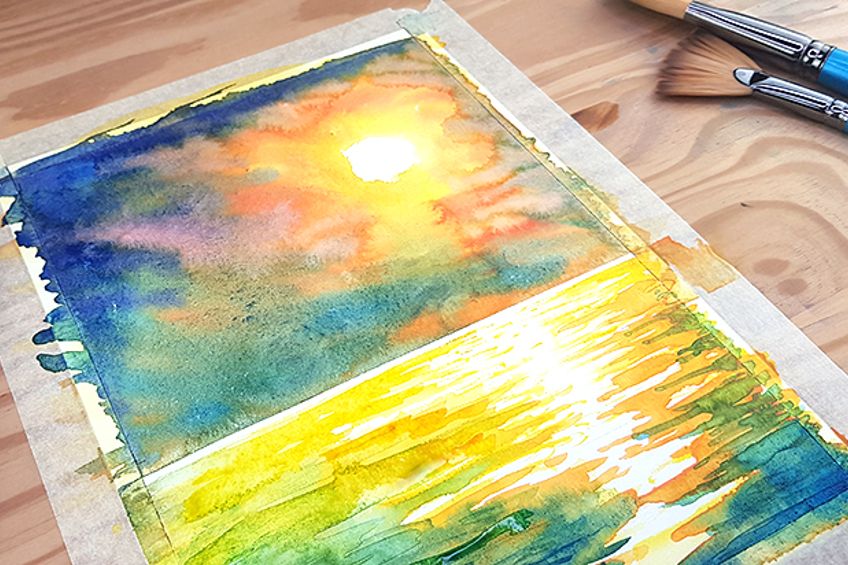
- Keep your marks loose to achieve the painterly effect, one way to do this is by holding the end of the brush rather than holding it like a pencil.
- Allow the painting to dry after the first application of colors. We want the background to be completely dry before painting marks over.
- It’s a layering process, so you always want to start light and slowly move to dark.
- Doing easy watercolor landscapes always starts with a sketch, so try to refine your landscape roughly in pencil before you begin to paint.
Hopefully, this tutorial has given you some insight into a few of them. But the most important part is to allow yourself to interpret the scenery you want to paint. When doing a watercolor landscape you can get away with a very expressive approach which often results in a beautiful image. So always have fun with it because it often is conducive to the best results.
Frequently Asked Questions
How Do You Paint a Watercolor Landscape?
All landscapes are different, which means it starts with choosing the right landscape. Then it’s about doing light and loose sketches on the page. We then want to build the landscape which means that we want to start with the background first. In order to do this, we wet the entire page with a thin layer of water and then start to apply, through a wet-on-wet approach, the colors we want for our landscape. They can be warm, light, colorful, or natural. Then it’s about slowly adding layer over layer. We are working with an additive process which means it is a layering process that involves adding layers. So always work light to dark.
What Are the Different Watercolor Techniques?
There are various watercolor techniques. In this tutorial, we go through some of them such as wet-on-wet for instance. This technique is where we apply our wet paint to our wet surface. This is good for soft and blurring backgrounds, as well as creating seamless gradients. Another technique is dry brushing. This technique is great for adding details toward the end of the softer tones. This is because we are applying dry paint which then will have less of a translucent quality, which will result in a stark appearance. These are just a few that are helpful for watercolor landscapes.
How Do You Paint Water in Watercolor?
Water is actually quite simple to paint. With water you need to understand that there are various ways it can be, sometimes settled and sometimes motion. With ripples in the water, it is about creating quick and swift strokes with a wrist generally moving along the plain of your landscape. This means if the plain of your landscape depicts a scene where the water should be moving horizontally then we want to make swift strokes with wrist from left to right. We use light tones first and then we can and in darker strokes to give a sense of reflection variations. Lastly, you want to keep negative moments or white moments in the water to diversify the shine effect on the surface of the water.
How to Paint an Easy Watercolor Landscape?
When doing nature paintings with watercolor or just trying to produce an easy watercolor landscape it always starts by doing a rough sketch first. We want something to guide our watercolor landscape. Secondly, we want to develop the background around an event horizon, this is where we add the colors on a wet surface that will fade and produce an effect of distance that we can paint our foreground over. Then lastly, once the background is dry we can paint or foreground over that to create a unique depth in our scenery. Whatever you paint in the foreground is your choice but these are the general principles of the application process for an easy watercolor landscape.
Matthew Matthysen is an educated multidisciplinary artist and illustrator. He successfully completed his art degree at the University of Witwatersrand in South Africa, majoring in art history and contemporary drawing. The focus of his thesis was to explore the philosophical implications of the macro and micro-universe on the human experience. Matthew uses diverse media, such as written and hands-on components, to explore various approaches that are on the border between philosophy and science.
Matthew organized various exhibitions before and during his years as a student and is still passionate about doing so today. He currently works as a freelance artist and writer in various fields. He also has a permanent position at a renowned online gallery (ArtGazette) where he produces various works on commission. As a freelance artist, he creates several series and successfully sells them to galleries and collectors. He loves to use his work and skills in various fields of interest.
Matthew has been creating drawing and painting tutorials since the relaunch in 2020. Through his involvement with artincontext.org, he has been able to deepen his knowledge of various painting mediums. For example, watercolor techniques, calligraphy and lately digital drawing, which is becoming more and more popular.
Learn more about Matthew Matthysen and the Art in Context Team.
Cite this Article
Matthew, Matthysen, “Watercolor Landscape – Easy Waterfront Scene Painting Tutorial.” Art in Context. January 31, 2022. URL: https://artincontext.org/watercolor-landscape/
Matthysen, M. (2022, 31 January). Watercolor Landscape – Easy Waterfront Scene Painting Tutorial. Art in Context. https://artincontext.org/watercolor-landscape/
Matthysen, Matthew. “Watercolor Landscape – Easy Waterfront Scene Painting Tutorial.” Art in Context, January 31, 2022. https://artincontext.org/watercolor-landscape/.




